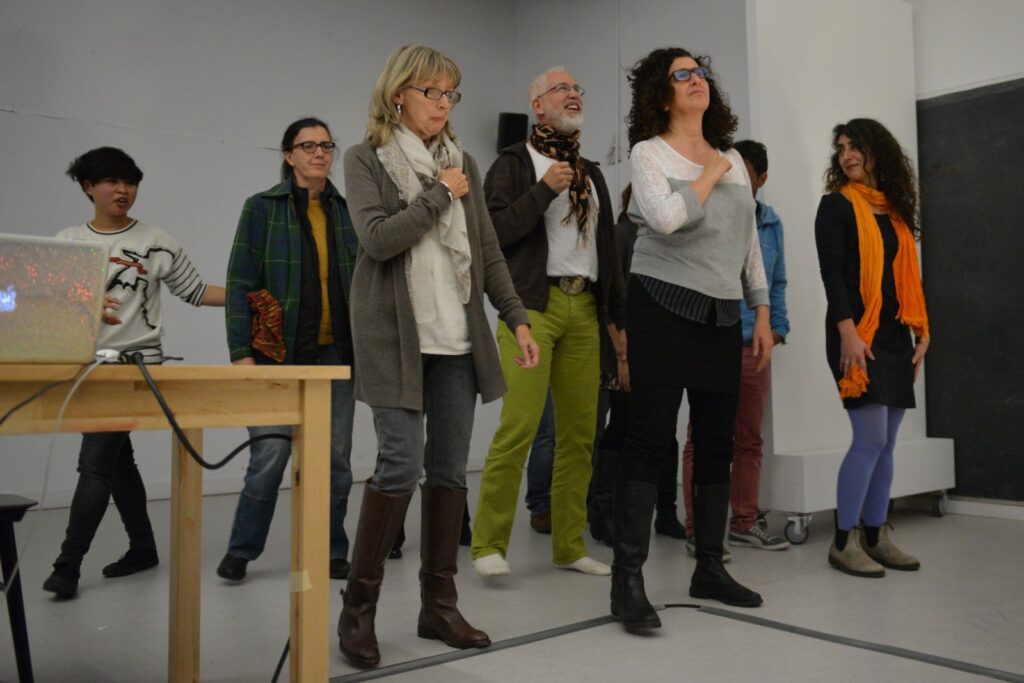By Alison Cooley

Serena Lee begins Layers Channels Paths History by dividing the audience into sections of green, brown and “nothing.” The unexplained designation recalls Jane Elliot’s “Blue Eyes Brown Eyes Exercise,” sets a political tone. Establishing boundaries between audience members, Lee has already begun to map out our relations to each other. Someone shoots “Woo green!” when Lee designates new compatriots for green. There’s the distinct impression we’re on teams now. The “nothings” look puzzled but a bit relieved. As latecomers join the group, Lee breaks mid-photoshop-tutorial to quickly assign them colours, and then returns to a peppy, youtube-style cartography workshop. Despite her use of photoshop, the fragments she works with appear ornate, historic. She briskly runs through the zoom function, the magic wand tool, the selection and deletion of map features, the channels/layers/paths/history sidebars, all the while commenting on the nature of cartography: speaks of her map’s elements in terms of economic “use,” introduces the compass and the cartouche (and their corresponding roles in trade and politics), the sense that a scroll suggests the map might just be unrolled like a carpet across territories.
Her educator persona breaks, briefly. Lee disappears briefly behind a movable partition. In a deeper tone, loaded with mystery and gravitas, she tells us a story. There’s a king, a prince, a map, a dagger. The king builds a wall and burns the books. (Is this the story of the Qin Empire? The details are too loaded with the conventions of fairytales to tell for sure.)


At various points Lee flits between an ink drawing workshop on an overhead projector (which, like the photoshop tutorial, takes on the clean eagerness of a corporate seminar), these bits of story, and something entirely more theatrical. She calls the “browns” up to the front while a projection of a robotic vaccuum cleaner on grass plays beside us. The white noise obscures her hushed tones, as she gives directions, drawing with pen on the palm of her hand. They’re the furiously-paced directions of a local trying earnestly to inform tourists of the best ways to get around a city—avoiding uphill climbs, watching out for that road that turns back in on itself—but soon the directions, like everything Lee has done so far, take on a futility. The crooked line on her hand loops back upon itself, jagged zig-zags cut it up and down. There are references to the city of London, but it’s unclear where the final destination is. Just “and then you’re there!” Half of the browns are sent away while the other half is instructed to march in place, and Lee belts “You’ll Never Walk Alone” in beautiful, dramatic, singer’s tones.

Earlier in her projected seminar, Lee had used overlapping mylar transparencies in green as a demonstration in how to fill in territory. Now, she does the same with brown. But instead of transparencies, she uses construction paper. She calls out for suggestions from the crowd: different shades of green? Now different shades of brown? Slowly, she obstructs her projection with brown triangles, until the projection is completely covered.
Lee’s narratives, which borrow the language of familiar circumstances, only to awkwardly twist their usefulness, are compelling in their incredible sense of storytelling about the world. But this world is not fantastical, removed. Lee’s world is our world, and I begin to wonder if the political implications of her stories (told obliquely through the comfortable territories of musical theatre, workshop, whispered directions, applause, and laughter) have been manifest in these media all along. What is the double-speak of the corporate seminar on networking in the arts, for example? Lee’s tongue-in-cheek take-down of the conventions of cartography is rather overt, and its jumps, its quick changes of character, its total comedic effect, convince us to come along for the difficulty of re-thinking territory. Alongside the cartography, though, comes the proposition that the social ways we come to deliver workshops, choose our teams, tell stories, also have in them the subtle re-tuning of our psyches.
